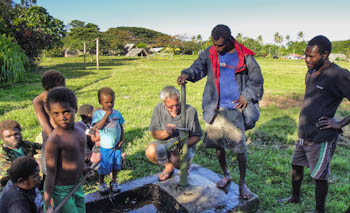
Tenaya
August
2012
Part Four
Jim Goes Back to Work
Port Resolution, Tanna
| |
| HOME |
| About Tenaya |
| About Us |
| Latest Update |
| Logs from Current Year |
| Logs from Previous Years |
| Katie's View |
| Route Map |
| Links |
| Contact Us |
![]()
August 30, 2012
Those of you who know Jim know that he loved his job as president of Eastpak, Kipling and JanSport Europe. Perhaps you were surprised when he retired and suspected that he would return to work one day. You would have been right. He has been very busy working here on Tanna.
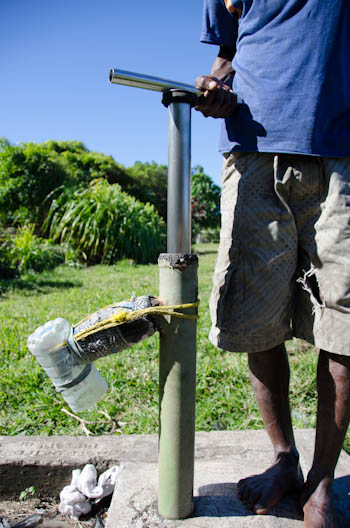
Twenty years ago an aid group built a pump for the village of Ireupouw at Port Resolution. It no longer pumped very well as the pipes had rusted and had been replaced by cut up plastic bottles tied together with cloth and rope. The day we arrived Carolyn asked if it could be fixed. "I'll have a look at it," Jim said. He was to utter those words many more times while on Tanna. Some of the following stories are in Jim's words, others in mine.
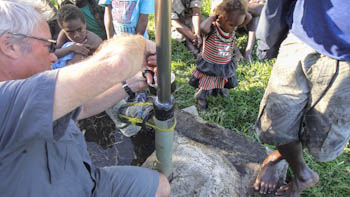
I was able to fix the pumping part with pieces I had on board Tenaya, but for the new spigot, I was lost. Then Sylfia, a large, home-built ketch came into the bay and on board they carry everything, yes everything! A piano, a drill press, a lathe, a dirt bike, and lots and lots of pieces of pipe and hose.
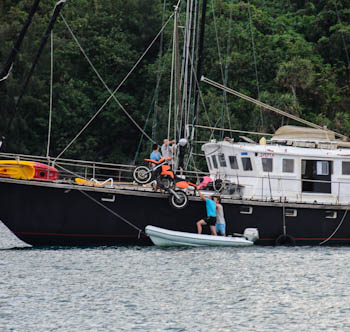
Martin was happy to help so we rummaged around to find the perfect pieces and now the pump should be good for another 20 years. In this land where strong penises are revered and celebrated, Katie thinks they might not be completely thrilled with the new look.
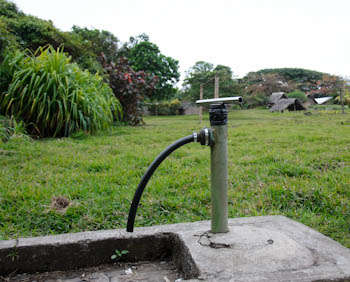
People would paddle out to Tenaya or find us when we were sitting around the village with something that needed fixing - solar powered lights, battery operated speakers, mp3 players, flashlights and even watches. And lots of old mobile phones. Katie loved to tell them I could fix anything but I was amazed at the number of items that I and other yachties really did fix.
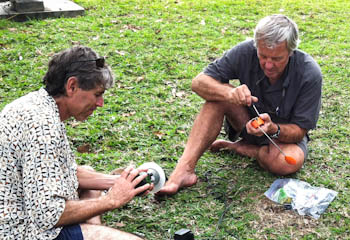
Forty years ago my brother and I purchased an industrial sewing machine and decided we could sew backpacks. It didn't take long before we had done something wrong and it no longer worked. We could not afford to have a real mechanic fix it so we started to take pieces apart. After a few attempts we were amazed to learn how a sewing machine works.
It took a lot of time before I could actually fix a machine but I did learn the basics of operation and what all those little parts actually did. Luckily our business grew and we hired a full time sewing machine repair man.
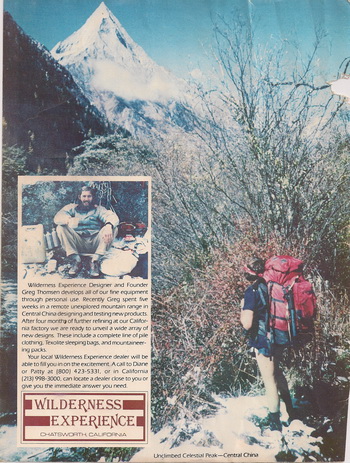
I didn't think about sewing machines again for 40 years. I hated sewing machines. They always stopped working and had so many different parts and adjustments that it took hours to figure out what was even wrong and then hours to fix it by trial and mostly error. I was sure I would never have to fix a sewing machine again.
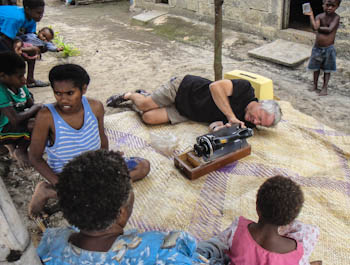
Then I met Leah, a widow and mom who earns money making skirts, about $5 each. For a day or two of work, she covers the cost of fabric and makes a small profit. Sadly, her machine had not worked for many months and no one had been able to fix it.
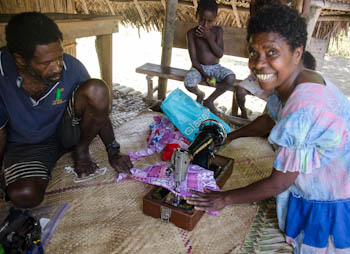
Of course I said that I had worked on sewing machines and would be more than happy to try to fix hers. Sitting on a mat woven from leaves, surrounded by curious kids, I took the machine apart and put it back together .... maybe 6 times. These are actually simple machines powered by a hand crank, basically the same design Singer has been using for 100 years.
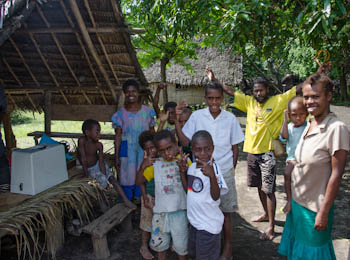
If I were somewhere other than an island in a third world country, in the middle of the Pacific Ocean, I would have replaced some parts and had it working pretty quickly. But there are no extra parts here. In fact, Leah only had three needles so I felt terrible when I broke one.
After a couple of hours the machine was working as good as new and Leah was beaming. Every time she saw me she thanked me again. And every time she talked to anyone with a sewing machine, she told them I could fix it.
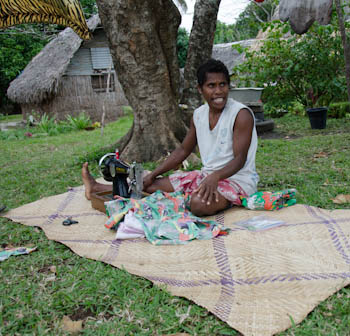
Serah's machine worked fine, but her daughter, Juluen, had heard from Leah that I could fix them so she told Elsie. Elsie's machine was much easier to fix than Leah's.
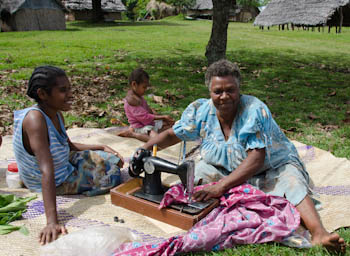
I would be working on a machine and look up into the group of people watching me to see someone else standing there with a sewing machine in her arms.
Jenna's machine wouldn't even turn when I started working on it. I got that part fixed but it still needed a tension spring. I hoped to buy one in Port Vila to send to her but could not find one. In fact, we had to be very careful when asking for the part because we let slip that I had fixed some machines and the lady we were talking to had four that were broken. We changed the subject and quickly left!
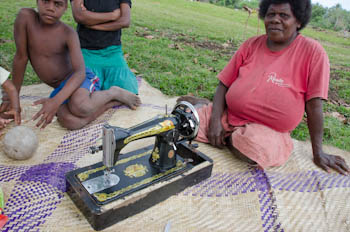
One day I was asked if I could make some passport photos for three men from Port Resolution. No problem, I took a white sheet and hung it on the wall of a hut and took pictures of 12 men.
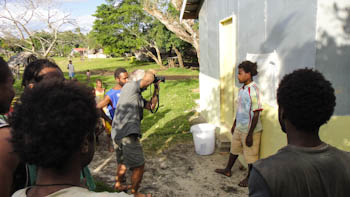
Some were for passports. Men go to New Zealand for a few months to pick fruit and make enough money to add corrugated metal to their house. But, it turns out, these were not for passports but for identity cards they need to play in the official soccer tournaments.
To get a picture they must to travel to Lenekal, on the other side of the island, either a full day walk or an expensive truck ride. There the photos cost about $15 each. That is what a trained guide leading people to the summit of the volcano makes in one month!
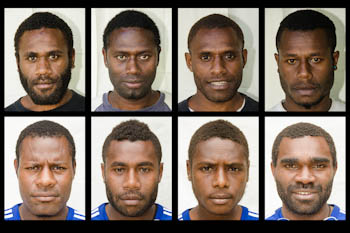
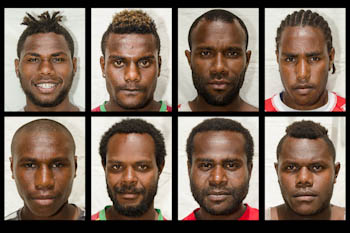
When word got out that we could take and print perfectly sized passport photos, well, I wish other businesses I've started would have grown so quickly!
One day Werry from Port Resolution Yacht Club asked if we'd be willing to take photos of the guys from Sulfur Bay. Yes! In fact, we would go there because we wanted to meet Chief Isaak, head of the John Frum Movement there.
When transport couldn't be arranged, 51 guys from two villages, Ipeukel and Namakara, walked three hours from Sulfur Bay. They know a short-cut through the gardens that we would never find. With them they brought baskets, feathers, a mat and a kava root. For the photo shoot, they each wore the same team shirt. It took a while because each guy had to first put this shirt on then fix his hair.
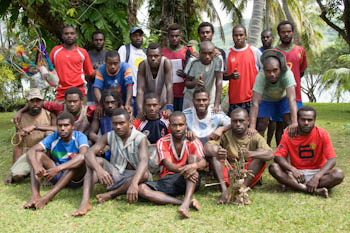
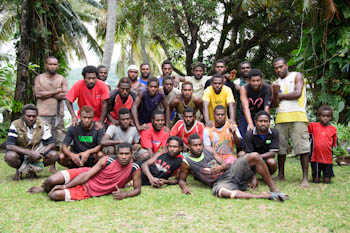
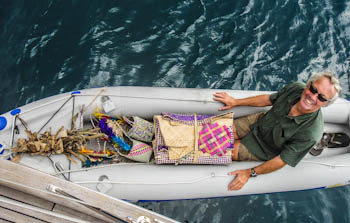
We returned from a traditional circumcision ceremony in Manuapen to find Tenaya pointing bow into the wind, normal for a boat at anchor. However, when we left early the previous morning, she had a stern anchor out keeping her into the swell.
Hot, sweaty and tired from the hike back, I was happy to dive in and find what had broken. Fortunately we had buoyed the anchor to let others know it was there, so could find it easily. The rode had frayed and snapped near the thimble.
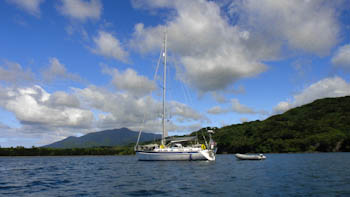
I dove down 5 meters (high water, of course) to find the anchor completely buried in the sand. Digging it out, I was able to thread a 10 meter dockline through the shackle. Jim was in the dinghy and went back to Tenaya to get one of our nice 100 meter lines because he no longer trusted the original rode.
About this time, as I bobbed at the surface holding onto the line connected to the anchor, 7 guys paddled up in two canoes wanting Jim to take passport photos. "I'm sorry, this is not a good time," I said. Although they looked completely dejected, I had no desire to deal with photos at the moment and tried my best to ignore them. Eventually they paddled back to shore.
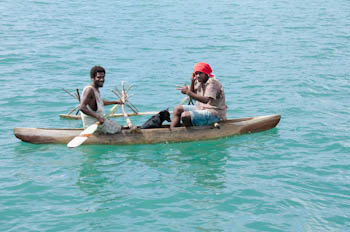
Once all was sorted and Tenaya was back in position, two of the guys, along with a dog, paddled back out and asked again for photos. Maybe they'd heard Americans are fond of dogs? Turns out they are from Sulfur Bay but could not come with the original group. Having walked three hours, I understood why they were so persistent.
Jim gathered his camera, flash and sheet and paddled in to take their pictures. One guy had a red shirt on his head that we though was for shade but it was their best shirt and each and every guy put it on for his photo. They were the nicest people you could hope to meet.
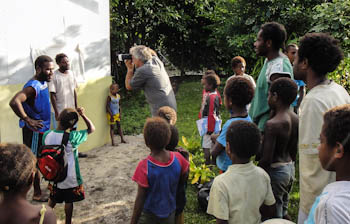
It was easy for Jim to take passport photos just about anywhere. Because the demand was so great, he began carrying his bit of white sheet along with his camera every time he went on shore.
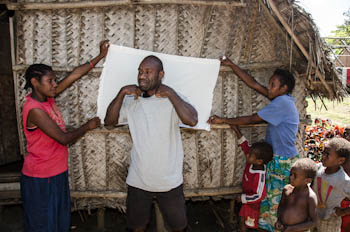
Sometimes he didn't even need to leave the boat. The guys would paddle out to him and a studio was quickly set up inside Tenaya.
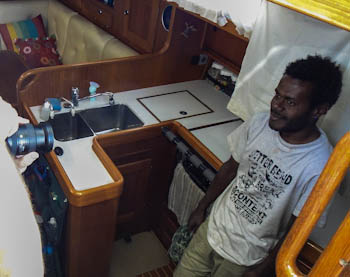
On our last trip back to the US we purchased an Epson Charm 4x6 photo printer. Using Adobe Lightroom to set up a photo with 8 passport sized pictures is easy and quick. But still, to take pictures of more than 120 people, print out 4 pictures each and cut them neatly apart becomes a very time consuming project.
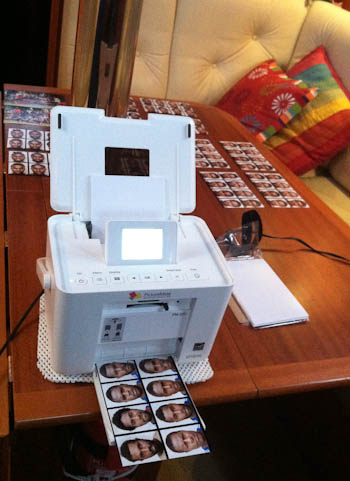
More fun was taking pictures of families; husbands, wives and children who had never owned a picture of themselves.
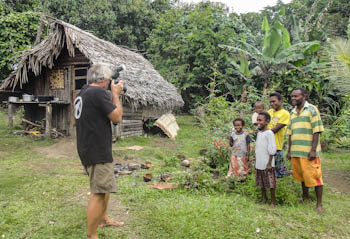
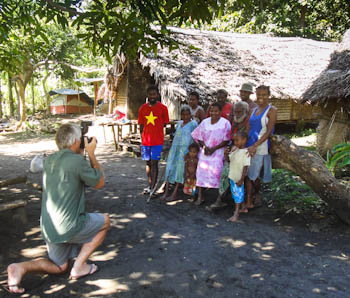
It was fun to take the passport photos and meet so many of the men from the nearby villages. Even better was that I became know as the "Photographer" and was welcome to take pictures of everyone, their homes, children, meals, etc. Lots of kid pictures! Those are my favorites, partly because the children are so happy and mostly because they just look so good.
We tried to make sure we printed pictures to give to parents, our favorites in acrylic frames. During our 3 months in Vanuatu we printed more than a thousand 4x6 pictures. I would have printed even more if we would have had more paper and ink.
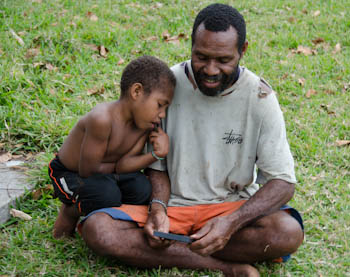
One of my goals for this year was to visit the village where the John Frum Movement is centered and perhaps meet the famous Chief Isaak, head of the religion.
Being the official photographer for the village team proved to be the very best introduction. As Katie and I tentatively walked into the village weighed down by our backpacks, we were met by a woman who invited us in. We were introduced to Chief Issak and then met by his son, Moli, captain of their football team.
Chief Isaak was happy to explain their beliefs to us and was sorry we had arrived too late to see him lowering the US flag for that day. He brought out some pictures of himself, which Jim promptly photographed, as well as capturing some images of the man himself.
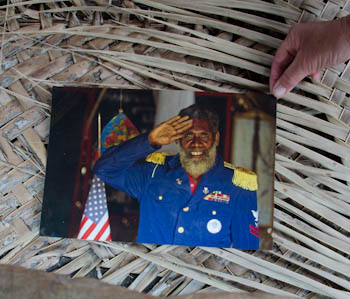
Although many tours visit Ipeukel, the John Frum village at Sulfur Bay, tourists are not allowed to see the nakamal during evening kava time. But Moli grabbed me (women are forbidden so Katie went off with his daughter-in-law) and took me to the quiet gathering of men while they had kava and talked in hushed tones. Not only was I welcomed, but more than 30 men came up to shake my hand and thank me for the photos. Then I sat with Chief Issak and Moli and drank a few bowls of kava.
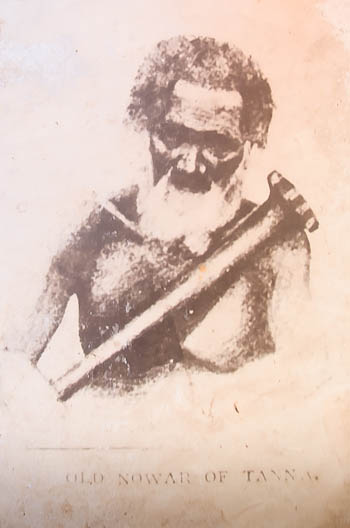
This is a picture of Chief Nowar taken by the first missionary to be accepted in eastern Tanna. He was a strong and popular chief, keeping his people safe from the cannibalism of other tribes. In the picture he is holding a lethal weapon. His grandson still has the original picture but it was frayed and probably wouldn't last much longer. I was able to take close up photos of it, clean them up in Lightroom, and print out new 4x6 copies.
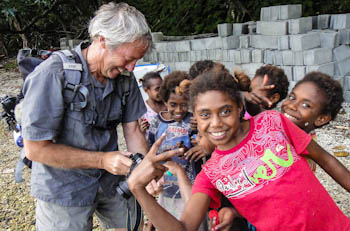
It is always so much fun to show the people I've just photographed the picture on the back of the camera. This usually brings smiles, laughs and approval for more.
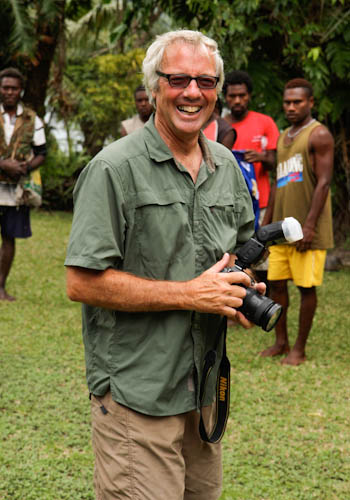
Becoming a professional photographer, even if the income is food, baskets, feathers and kava, I think I should should be allowed to write off the expenses of Tenaya and our travels. But it turns out it is not that simple. See my back and forth correspondence with our accountant regarding the tax situation for payments:
see: Correspondence with accountant
Go to August 2012 part five - Yachties, Welcome to Port Resolution